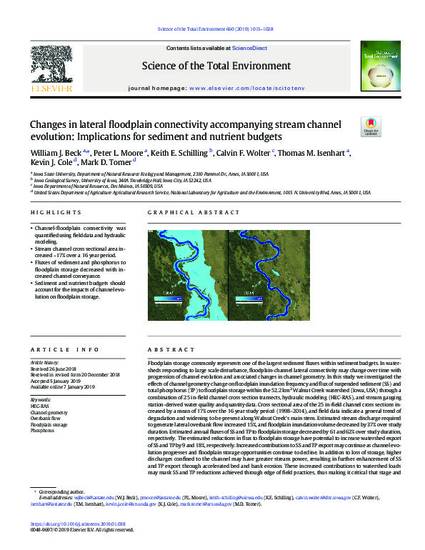
Floodplain storage commonly represents one of the largest sediment fluxes within sediment budgets. In watersheds responding to large scale disturbance, floodplain-channel lateral connectivity may change over time with progression of channel evolution and associated changes in channel geometry. In this study we investigated the effects of channel geometry change on floodplain inundation frequency and flux of suspended sediment (SS) and total phosphorus (TP) to floodplain storage within the 52.2 km2 Walnut Creek watershed (Iowa, USA) through a combination of 25 in-field channel cross section transects, hydraulic modeling (HEC-RAS), and stream gauging station-derived water quality and quantity data. Cross sectional area of the 25 in-field channel cross sections increased by a mean of 17% over the 16 year study period (1998–2014), and field data indicate a general trend of degradation and widening to be present along Walnut Creek's main stem. Estimated stream discharge required to generate lateral overbank flow increased 15%, and floodplain inundation volume decreased by 37% over study duration. Estimated annual fluxes of SS and TP to floodplain storage decreased by 61 and 62% over study duration, respectively. The estimated reductions in flux to floodplain storage have potential to increase watershed export of SS and TP by 9 and 18%, respectively. Increased contributions to SS and TP export may continue as channel evolution progresses and floodplain storage opportunities continue to decline. In addition to loss of storage, higher discharges confined to the channel may have greater stream power, resulting in further enhancement of SS and TP export through accelerated bed and bank erosion. These increased contributions to watershed loads may mask SS and TP reductions achieved through edge of field practices, thus making it critical that stage and progression of channel evolution be taken into consideration when addressing sediment and phosphorus loading at the watershed scale.
Available at: http://works.bepress.com/thomas_isenhart/61/

This article is published as Beck, William J., Peter L. Moore, Keith E. Schilling, Calvin F. Wolter, Thomas M. Isenhart, Kevin J. Cole, and Mark D. Tomer. "Changes in lateral floodplain connectivity accompanying stream channel evolution: Implications for sediment and nutrient budgets." Science of The Total Environment 660 (2019): 1015-1028. doi: 10.1016/j.scitotenv.2019.01.038.